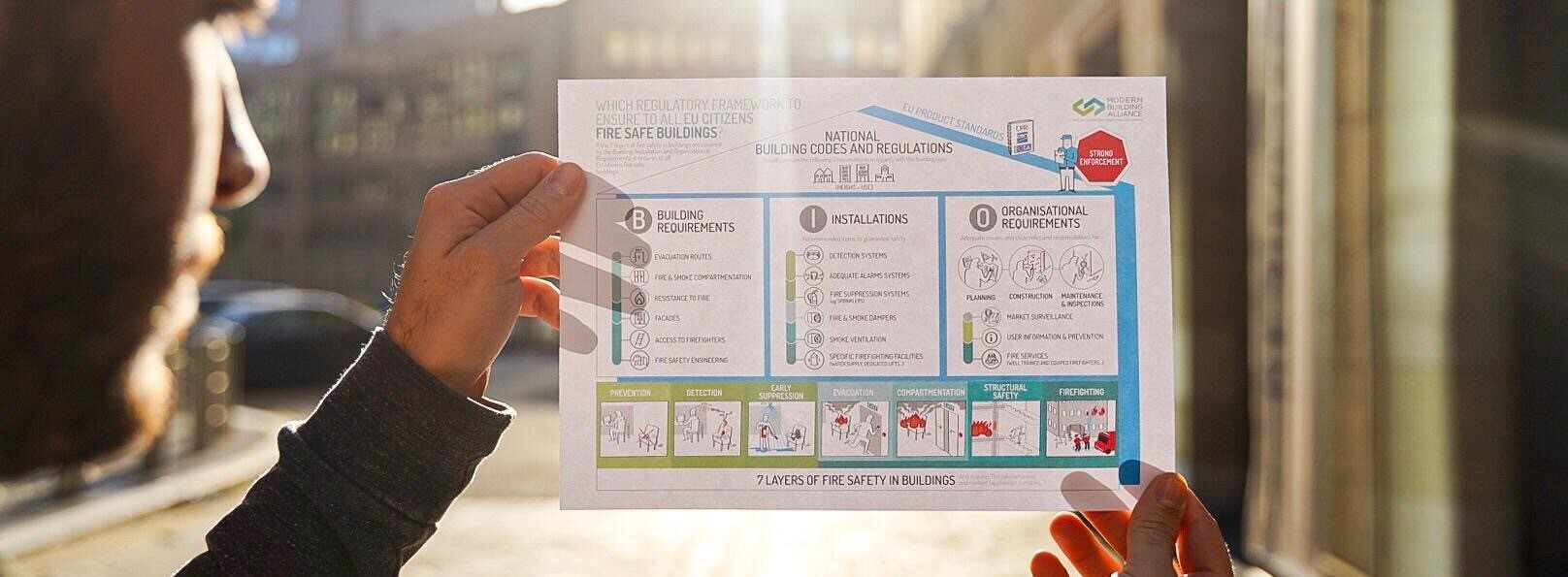
Proposed Regulatory Framework for fire safe buildings (B.I.O. framework for Fire Safe Buildings)
The Modern Building Alliance presents an original framework with a comprehensive and structured list of elements for the consideration of Member States in their regulatory approach to ensuring fire-safe buildings. This framework aligns with the EU subsidiarity principle and aids in structuring the exchange of information and best practices between Member States within the European Fire Information Exchange Platform (FIEP), established by the EU Commission in October 2017.
Closely linked to the 7 layers of fire safety in buildings, this holistic approach considers and clarifies not only the building design and construction but also technical installations and fire safety management throughout the building’s lifetime. The proposed framework includes clarifications of the roles and responsibilities in the value chain.
How can a practical framework help to protect citizens?
Fire safety in buildings must include these 7 layers:

First, all necessary measures should be taken to prevent fires. If a fire occurs, it must be detected as soon as possible. The manual or automatic equipment to extinguish it should be readily available and working correctly.
If the fire is not extinguished immediately, the main priority is to evacuate occupants to a safe place.
Fire compartmentation ensures that a fire and the resulting smoke do not spread to other rooms.
Even if the fire becomes larger, structural safety must ensure that the building will not collapse on the occupants or firefighters. Firefighters should be quickly alerted to secure occupants and avoid further damage.
These 7 layers ensure the coherence of fire safety measures.
Additionally, they must be implemented into national Buildings, Installations and Organisational requirements for fire-safe buildings backed by EU standards for products. Requirements depend on the type of building, notably their height and use. According to its type, buildings must meet appropriate fire safety design requirements.
This is what we call the B.I.O. framework.
BUILDINGS requirements cover all elements related to the structure, such as evacuations routes, compartmentation or access areas for firefighters.
In complex buildings, the application of Fire Safety Engineering methods enables buildings to be designed that will have a minimum impact on a fire.
INSTALLATIONS are equipment that are essential contributors to fire safety layers, such as smoke detectors, adequate alarm, fire doors and fire suppression systems.
Building and installation requirements are not sufficient on their own. They also require strong ORGANISATIONAL measures to ensure proper enforcement:

- During the design phase, all players involved in the realisation of the building project must work together responsibly to ensure the building design meets all the fire safety requirements.
- During construction, the performance and installation of systems, products and equipment must be carefully verified so that they correspond to the design and fire safety requirements.
- Inspections of existing buildings are vital to ensuring that maintenance is being carried out correctly and to identify possible modifications, breaches or improvements.
In Europe, defining the specific Building, Installation and Organisational requirements to match various construction traditions is the responsibility of each Member State.

Member States must also pay particular attention to the enforcement of the fire safety requirements and compliance of buildings.
The EU supports Member States via the harmonised standards for testing and classifying the performance of fire safety and construction products used in buildings. This allows all producers to present clear information about their products’ performance when selling them on the single market. Additionally, this encourages building designers to select products that meet the national performance requirement for the specific application.
Applying the holistic 7 layer approach to fire safety in buildings – fully addressing and applying it to well-enforced national BUILDING, INSTALLATIONS and ORGANISATIONAL requirements backed by EU standards – will provide an efficient framework to ensure that all EU citizens are safe from fires in our buildings.
About the B.I.O. framework
The B.I.O. framework was presented in draft format at a meeting of the European Fire Information Exchange Platform (FIEP) in June 2018. Since then, it has been discussed and enriched by many stakeholders, including the network of the European Fire Safety Alliance. A full paper was been presented during the symposium on Fire Safety Façades in Paris, 26 September 2019. Finally, the concept shaped the agenda of the ‘Building Day’, on 19 November 2019, a full-day event related to fire safety in buildings that took place during the first European Fire Safety Week. The Modern Building Alliance and other partners of the event are calling on national regulators to exchange best practices on all the aspects of the framework with the FIEP.
RELATED CONTENT
Fire Safety Competency
EU Fire Safety Guide
B.I.O. FACTSHEETS
Factsheet on Sprinklers
